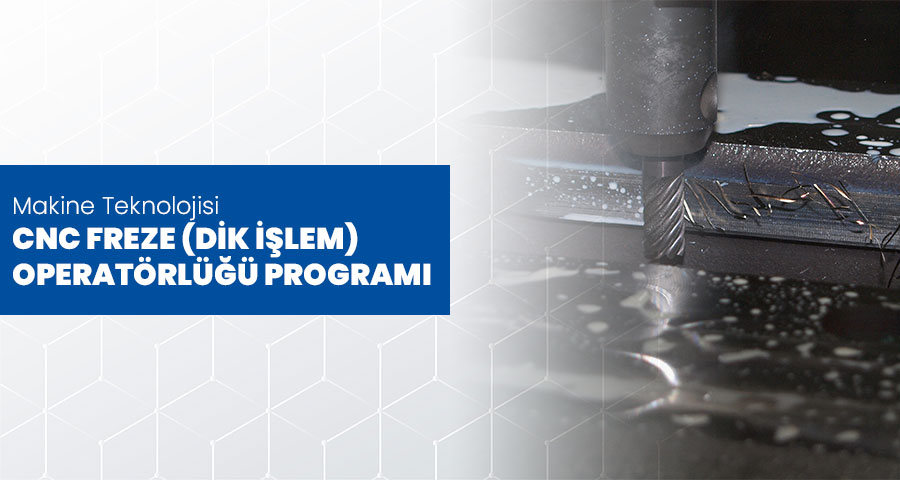İşleminiz Devam Ediyor.
Lütfen Bekleyiniz...
Lütfen Bekleyiniz...
CNC Milling (Mitsubishi Vertical Processing) Operator

| HOURS | SUBJECT | SYLLABUS | |
|---|---|---|---|
| 4 | 1. CNC MILLING MACHINES | • Structure of Milling Machines • Body, Register, and Slides • Cooling, Lubrication, and Air Systems and Engines • Axis Shafts, Guide Types, and Their Effects on Work • Current Protection Units (Regulator and UPSs) • Magazine Types and Working Principle • Control Panel and Its Types • Checks to be made before the machine is started • Lubricants Used on the Bench and Their Purposes • Starting the Machine and Sending the Cutter to Machine Zero • Manual Mode and Advanced Options |
|
| 6 | 2. CONNECTING THE WORKPIECE IN CNC MILLING | • Effects of Tying Method on Job Sensitivity and Job Efficiency • The Importance of Proper Tying in Mass Production • The Importance of Tying in terms of Occupational Safety • Important Points to Consider in Connecting the Parts and Choosing the Right Order of Operation • Selection of the Appropriate Connection Type According to the Part Form • Connecting the Work to the Bench Table with Bolts and Shoes • Attaching the Vise to the Table of the Workbench and Attaching the Work to the Vise • Job Binding with a Rotating table • Job Binding with Magnetic Table • Job Binding with Sine Table • Linking Business with Business Patterns • Checking the Connected Job |
|
| 4 | |||
| 4 | 3. CONNECTING CNC MILLING TOOLS SUITABLE FOR MACHINES | • Holders and Tools • Tool Selection According to the Operation to be Performed • Selecting the Appropriate Tool for the Material to be Processed • Manual Tool Change • Automatic Tool Change • Magazine • Holders and Cutters that can be connected to the magazine • Selection of Appropriate Holder and Cutter • Connecting the Holder to the Appropriate Slot • Convenient and Safe Attachment of the Cutter to the Holder • Connecting and Control of Breakers |
|
| 8 | 4. TOOL SETTING ON CNC MILLING | • Reference Point and Intended Uses • Elements Used in Recording the Reference Point and Their Properties • Determining the Reference Point of the Work • Master Tool Reset • Saving the reference point • Saving Multiple Reference Points and Purposes of Use • Multiple Tool Reset by Workpiece • Tool Height and Diameter Compensation Values • Manual Chip Removal from the Workpiece |
|
| 4 | |||
| 6 | 5. USING THE CONTROL PANEL OF CNC MILLING MACHINES | • Panel Control Functions • On-Screen Menus and Explanation • Program Keys and Functions • Operation Control Keys and Tasks • Manually Moving the CNC Milling Machine • Rearrange Programs Found in CNC Milling Machine • Running Programs Found in CNC Milling Machine |
|
| 4 | |||
| 8 | 6. CNC MILLING READY PROGRAMMING | • Writing and Saving Programs to the Machine Memory • Running a Ready Program from the bench memory • Running Program from USB Connection • Running Programs with SD Card • Running Program from RJ 45 Port • Program Run from RS 232 Port • Program Transfer from Machine Memory • Transferring Programs from Memory Cards to the Machine • Writing and Running Temporary Programs in MDI mode • M3, M6, S, and M19 command operations • Testing the Program • Checking the Program's Logic and Spelling Errors • Running the Program with Simulation Mode • Testing the Program (Dry Run) • Operation of the Program • Operation in Step-by-Step Mode • Checking the First Produced Workpiece • Correction of Detected Measurement Differences (Offset) • Operating in Serial Mode |
|
| 8 | |||
| 4 | 7. GENERAL WARNINGS IN CNC MILLING | • Basic Alarm Codes • Warning Lamps on the Bench and Their Meanings • Lubrication Warnings and Lubrication Times • Air Pressure Values, Warnings, and Controls • Load and Forcing Warnings • Axis Motion Alerts • ATC Alerts • Write Protection (Edit Key) • Program Writing Error Warning |
|
| 4 | 8. MEASUREMENT AND EVALUATION | • Preparation, Operation, and Controls of the Machine • Correct Connection of a Given Part and Processing by Calling the Ready Program. • Checking the Workpiece • Final Checks, Cleaning, and Shutdown of the Machine |
|


